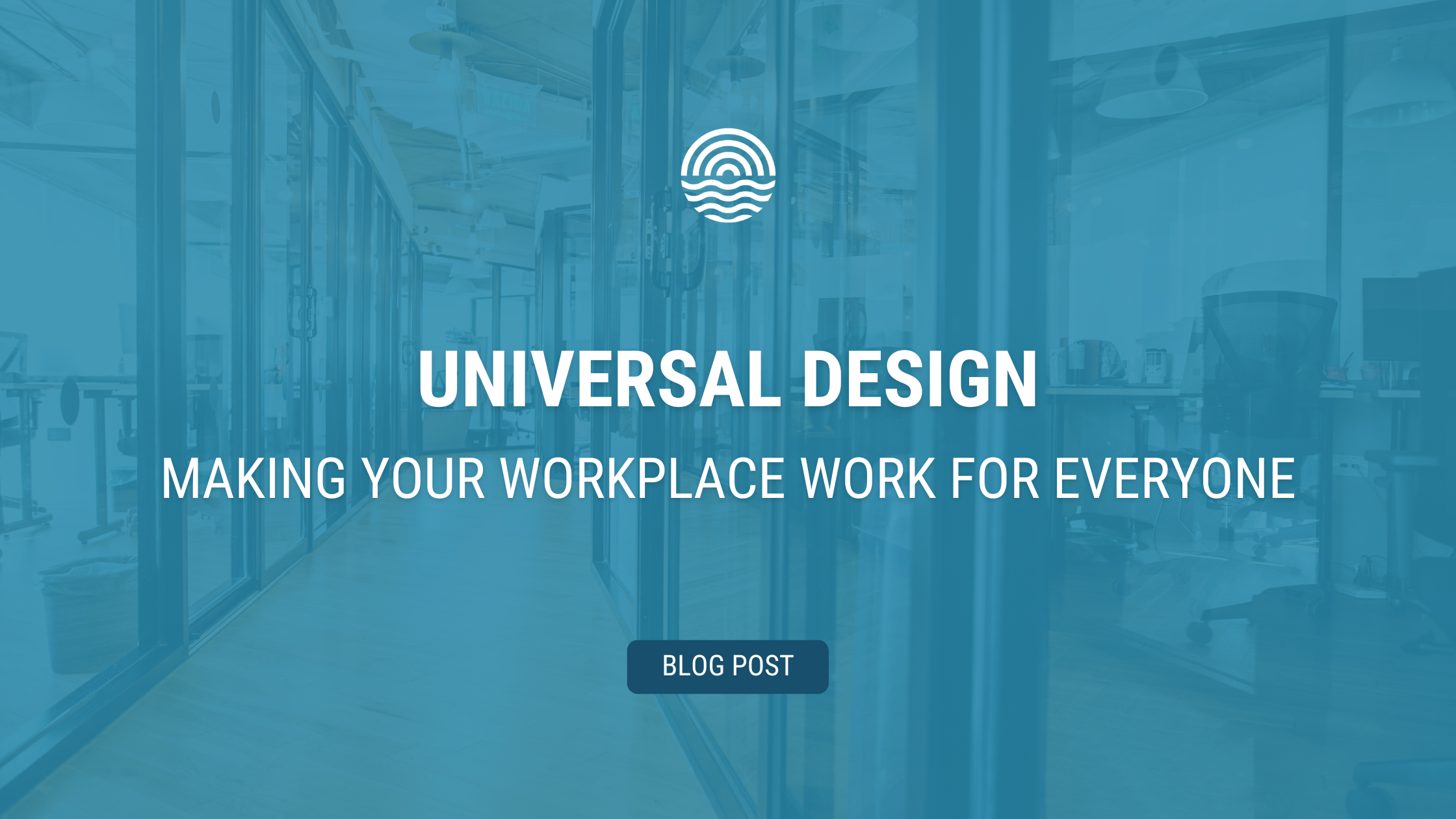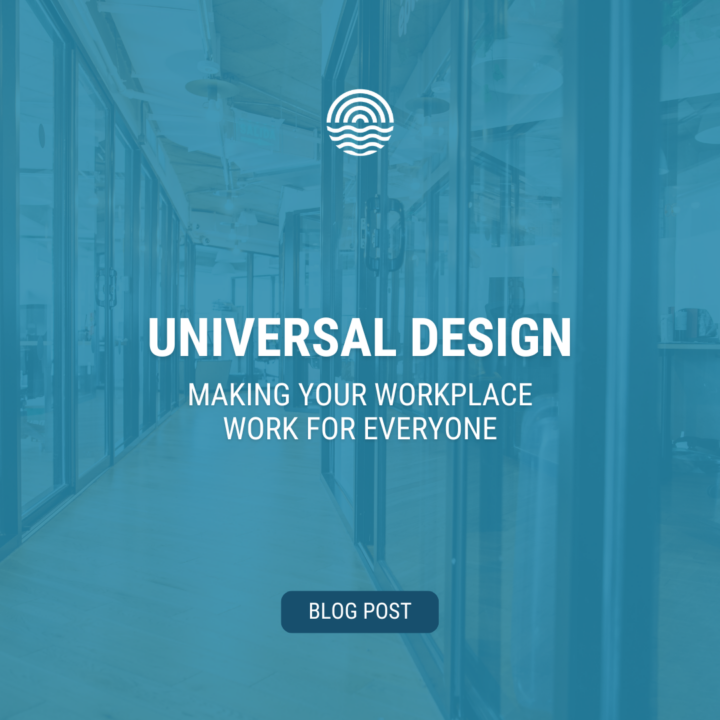
BLOG POST
Universal Design: Making Your Workplace Work for Everyone
While diversity in the workplace is celebrated, sometimes physical or cognitive limitations can create barriers that hinder employee participation and success. That’s where accessibility and universal design come in!
But what is universal design, and how does it differ from accessibility? Let’s dive in!
Accessibility: Removing the Roadblocks
Accessibility is about ensuring everyone has an equal chance to succeed. Think ramps, accessible restrooms, and assistive technology. These features remove physical barriers that can prevent people with disabilities from fully participating in the workplace.
Universal Design: Designing for Everyone
Universal design goes a step further.
It’s a concept aimed at creating products, environments, and systems that are accessible and usable by as many people as possible, regardless of their age, ability, or other characteristics. This approach promotes inclusivity and aims to accommodate the diverse needs of users without requiring adaptations or specialized designs.
When we start with good design, we are creating a barrier-free environment (or at least reducing barriers) while enhancing the experience for everyone. Automatic doors are an example of universal design principles in action. People with a mobility disability benefit from them, but also people with strollers, people carrying lots of groceries, or even during COVID-19 when many avoided high-touch surfaces such as door handles.
Key Principles of Universal Design
- Equitable Use: The design is useful and marketable to people with diverse abilities. It ensures that everyone can use it in an equal and non-stigmatizing manner.
- Flexibility in Use: The design accommodates a wide range of individual preferences and abilities. It allows users to choose how they interact with the product or environment.
- Simple and Intuitive Use: The design is easy to understand, regardless of the user’s experience, knowledge, language skills, or concentration level. It avoids complexity and prioritizes clarity and simplicity.
- Perceptible Information: The design communicates necessary information effectively to the user, regardless of ambient conditions or the user’s sensory abilities. This may involve using different modes of communication like visual, auditory, and tactile cues.
- Tolerance for Error: The design minimizes hazards and the adverse consequences of accidental or unintended actions. It includes features that help users avoid mistakes and mitigate the impact of errors.
- Low Physical Effort: The design can be used efficiently and comfortably with minimal fatigue. It aims to reduce strain and effort for all users.
- Size and Space for Approach and Use: The design ensures appropriate size and space for approach, reach, manipulation, and use, regardless of the user’s body size, posture, or mobility.
Benefits of Universal Design
- Inclusivity: Ensures that products and environments are accessible to a broader audience, reducing the need for specialized solutions and fostering inclusivity.
- Economic Efficiency: Reduces the need for costly modifications or retrofits by addressing diverse needs from the outset.
- Improved User Experience: Enhances the overall usability and user satisfaction for everyone, not just those with disabilities.
- Social Equity: Promotes equal opportunities and participation for all individuals in various aspects of society, including education, employment, and recreation.
- Improved Safety: Designs that minimize hazards and reduce the likelihood of accidents, such as slip-resistant surfaces and well-lit environments, benefit everyone, not just those with disabilities. Universally designed spaces are easier to navigate during emergencies, benefiting all users in crisis situations.
- Sustainability:
- Environmental Efficiency: Universal design often aligns with sustainable practices, such as energy-efficient buildings that accommodate all users while reducing environmental impact.
- Long-Term Usability: Products and spaces designed with universal principles in mind tend to have longer lifespans and require less frequent replacements or modifications.
Making Your Workplace Work for Everyone
Here are some ways you can implement universal design principles into your workplace:
Physical Space:
- Wide doorways and clear pathways: Ensure easy navigation for everyone, regardless of mobility limitations.
- Adjustable furniture: Provide standing desks, ergonomic chairs, and adjustable monitor arms to cater to different needs and postures.
- Lighting controls: Offer dimmers and adjustable lighting options to accommodate people with visual sensitivities.
- Clear and contrasting signage: Use large fonts, high contrast between text and background, and consider braille or tactile additions for improved accessibility.
Technology:
- Software with accessibility features: Look for programs with built-in screen readers, voice recognition, and keyboard shortcuts.
- Closed captioning on videos and multimedia presentations: This benefits people with hearing impairments or those in noisy environments.
- Accessible online documents: Use features like descriptive alt text for images and proper heading structures for easy navigation with screen readers.
- Multiple communication channels: Offer information and updates through email, video calls, and internal communication platforms to cater to different learning styles.
Work Practices & Policies:
- Flexible work arrangements: Consider options like remote work, compressed workweeks, or flexible start and end times to accommodate diverse needs.
- Clear and concise communication: Avoid jargon and technical language, and provide instructions in multiple formats (written, visual, etc.)
- Inclusive meeting practices: Encourage participation from everyone, offer breaks during long meetings, and provide recordings or summaries for those who can’t attend.
- Training and support: Educate employees about accessibility features in technology and the importance of inclusive communication.
Friendly Reminder: Universal Design Benefits Everyone!
The key is to be proactive and consider the needs of a diverse workforce when making decisions about your workplace. By keeping these universal design principles top of mind, you can create a work environment that empowers everyone to thrive!
Questions about driving meaningful DEI change in your business? We can help!


